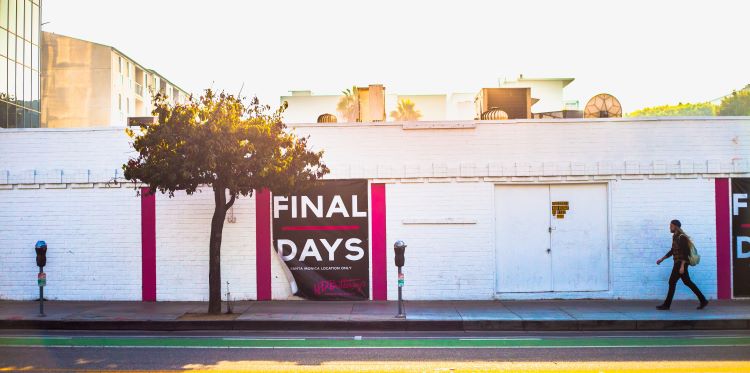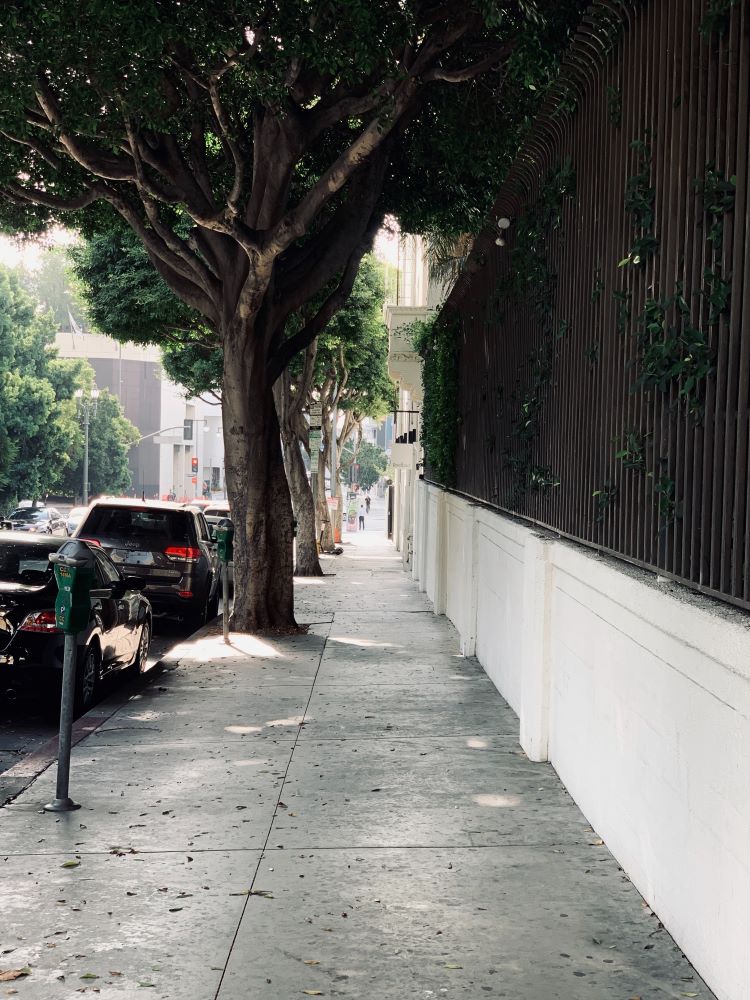When Will it be too Hot to Walk?
Brian Neshek | January 7, 2020

Temperature-safe streets are need to ensure walkability in the face of climate change.
As our global climate continue to change, temperatures are becoming increasingly hotter. Climate projections indicate that extreme heat days for an inland Southern California community such as Pomona, means more days with temperatures above 101.9° F. It might not be next year or even five years down the line, but the time will come when temperatures increase to a point where people no longer want to walk for exercise or complete daily tasks. We are already seeing typical summer activities needing to be shifted to cooler months, and research has found that participation in outdoor physical activity declines when temperatures exceed 84 °F.
The question becomes when is the tipping point? When will people decide it’s too hot to walk outdoors?
Walkability refers to how friendly an area is to walk. Models that rank areas based on walkability such as Walk Score, the National Walkability Index as well as indices found within the literature on walking behavior, currently do not prioritize criteria that will help combat projected temperature increases. If we do not create temperature-safe streets for pedestrians, they will likely to revert to car use and retreat into air-conditioned environments, leaving walkable infrastructure unused. Trees have the ability to decrease temperatures and cool streets as well as the surrounding city, proving the need for shade producing street trees to be prioritized when creating walkable areas.
Importance of Walkability
Greenhouse gas emissions are one of the leading causes of climate change. A contributing factor are the emissions released from the burning of fossil fuels used in different transportation options. In the United States, 29% of greenhouse gas emissions are caused by the transportation sector. A strategy to reduce the amount of greenhouse gas emissions from transportation is to increase alternative methods such as mass transit and active transportation like biking and walking. Walking is one of the more sustainable forms of transportation, as it contributes to reductions in air pollution by reducing the reliance on personal vehicles. According to Michael Southworth, Increasing walkability of urban areas potentially reduces greenhouse gas emissions by providing the infrastructure that connects people with a mixture of amenities such as work, food opportunities, social amenities, and other transportation options all within a reasonable amount of time and effort.

Current Walkability Prioritization
There are multiple ways of assessing the walkability of existing areas and criteria to follow when designing new ones. Websites such as Walk Score measures walkability on a scale from 0 – 100 based on walking routes to destinations such as grocery stores, schools, parks, restaurants, and retail. Walk Score analyzes hundreds of walking routes to nearby amenities. Points are awarded based on the distance to amenities in each category and measures pedestrian friendliness by analyzing population density and road metrics such as block length and intersection density. The National Walkability Index also promotes walkability for census block groups around the United States, by using a Smart Location Database that analyzes, density, diversity of land use, urban design, demographics, employment, and transit service.
Although most walkability models do not consider increase in temperatures and extreme heat days due to climate change, a study by Shay, Spoon and Khattak mentions that whether is contributing factor that influence walking habits, meaning that if temperatures continue to rise, they will have a role in weather people continue to walk or not.
Criteria previously identified has been used to create successful walkable areas, but none of them prioritize street trees, and canopy coverage as a walkability criteria, while some models omit it entirely. If accounted for, street trees are usually grouped within other categories as an afterthought. In some models, criteria pertaining to street trees can only be found under Quality of Path, which also includes path paving, width and surrounding landscape, illustrating it is just another factor and not a priority. Other models only mentioned street trees in regard to their aesthetic purposes rather having their own section highlighting benefits street trees provide the landscape.
Street Tree Prioritization
With rising temperatures already affecting parts of Southern California, street tree implementation and increasing shade should have higher prioritization when creating walkable infrastructure. There is a long list of benefits that trees provide to combat climate change that include storing carbon, cleaning the air, and conserving energy. However, one of the most important benefits trees provides is cooling. Over the past 50 years heat absorbing roads, and buildings have increased, while street trees and canopy coverage has declined, resulting in a six degree increase in average temperature in Southern California. Shade from tree canopy supports cooling street temperatures as well as the surrounding city, providing pedestrians a comfortable walking experience. Temperature safe streets increase the likelihood that pedestrians will continue walking and not reverting to car use. According to Tree People and the Environmental Protection Agency, trees cool urban areas through evaporation combined with shading from tree canopy reducing peak temperature by 2-10 degrees. The temperature reduction decreases the chance of heat related illness and/or death providing pedestrians a safer environment to walk.

Unsafe Temperature Streets
Increases in temperatures and extreme heat days will likely affect the amount people choose to walk in the future. According to the Center for Disease Control and The National Weather Service (NWS), heat is among the deadliest extreme weather hazards in the United States. Communities exposed to extreme heat suffer from increases in body temperatures and heat stress illnesses such as: heat cramps, heat exhaustion, and heat stroke that can lead to deaths. In addition, exposure to increased daily air temperature and extended periods of extreme heat have been shown to increase cardiovascular and respiratory mortality. Greater exposure to extreme heat days will likely cause a reduction in the number of pedestrians due to the unsafe temperatures that increase health risks.
As pedestrians worry about heat related illnesses or death, they will choose other options that do not include going out into the heat. Studies show that participation in physical activities increases up to 82–84 °F and begins to decline past that point. Warming temperatures also encourages individuals to take part in indoor leisure activities in lieu of outdoor activities.
In the case of transportation, indoor options include the likely hood that pedestrians will revert to car use and their controlled comfortable environment with air-conditioning, adding to the greenhouse gas emissions.
Impacts for the Future
With climate change increasing temperatures, priorities in walkability criteria need to shift to prioritize trees. The cooling benefits of trees have the ability reduce peak temperature by 2-10 degrees, allowing walkable temperatures to increase from 84°F to 94°F. Over the next 30 years Cal Adapt’s extreme heat modeling projects an average of 68 days per year of 94°F for inland southern California communities such as Pomona. Prioritizing street trees will add 68 walkable days over the next 30 years, days that would have been lost due to high temperatures. Providing temperature safe streets will encourage walking and in the long run reduce vehicular use which is beneficial for the environment and we all as the community.

Brian Neshek is a graduate student in the Master of Landscape Architecture program at California State Polytechnic University, Pomona. His work focuses on creating walkability and connections between communities while emphasizing the benefits green infrastructure has for the environment.